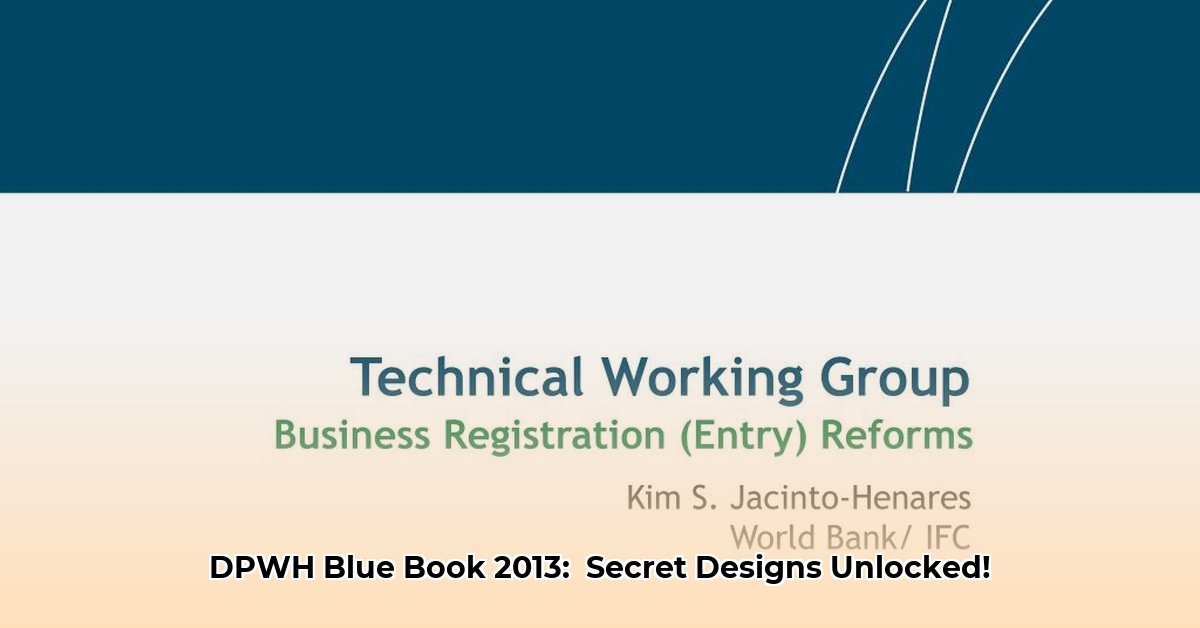
Navigating the Gap: The Elusive 2015 DPWH Blue Book Update
Finding the updated 2015 version of the Department of Public Works and Highways (DPWH) Blue Book—the essential guide for Philippine infrastructure projects—proves surprisingly difficult. You can try to find it here: DPWH Blue Book Download. While the 2004 edition remains widely accessible, the absence of a readily available 2015 update creates significant challenges for all stakeholders. This article clarifies the situation, outlines the implications of this information gap, and provides actionable steps to navigate this uncertainty.
The 2004 Blueprint: A Foundation Under Revision
The 2004 DPWH Blue Book served as the foundational document for many successful infrastructure projects. It established clear standards and best practices, guiding the construction of roads, bridges, and other crucial infrastructure. However, advancements in technology, materials, and construction techniques necessitate regular updates to maintain efficiency, cost-effectiveness, and compliance with evolving regulations.
The 2015 Update: A Missing Piece of the Puzzle
Department Order 047, Series of 2015 (DO 047, S2015), signaled a substantial revision of the 2004 standards. This update incorporated new technologies, improved materials, and enhanced best practices. However, widespread access to this crucial update remains severely limited, posing significant challenges for those involved in Philippine infrastructure development. This lack of accessibility raises questions about consistent standards implementation across diverse projects.
Implications of the Information Gap: Risks and Uncertainties
The absence of readily available updated specifications presents several serious risks:
Outdated Practices: Reliance on the 2004 specifications might lead to the use of outdated materials and methods, potentially resulting in less efficient, less cost-effective, and less environmentally sound projects.
Non-Compliance: Working without the latest regulations increases the risk of non-compliance, potentially leading to project delays, penalties, and increased administrative burdens.
Unforeseen Costs: Outdated practices can result in higher costs and unforeseen project delays due to inefficiencies and the need for rework.
A Strategic Approach: Short-Term & Long-Term Actions
Even without immediate access to the complete 2015 update, proactive steps can mitigate risks:
Short-Term Strategies (0-1 Year):
Strict Adherence to 2004 Standards: Prioritize strict adherence to the 2004 specifications, ensuring meticulous documentation of any limitations or deviations.
Proactive Communication: Engage in open communication with the DPWH and other relevant stakeholders to clarify any ambiguities and seek guidance on navigating the lack of the updated manual.
Thorough Due Diligence: While awaiting the updated specifications, conduct thorough due diligence to ensure that project designs and methodologies are compliant with existing and known standards.
Long-Term Strategies (3-5 Years):
Advocate for Accessibility: Actively advocate for increased accessibility of the 2015 update—perhaps through formal requests to the DPWH or lobbying efforts.
Continuous Learning: Stay abreast of industry developments and emerging technologies in infrastructure development. Seek training and professional development opportunities to familiarize yourselves with best practices.
Research & Development: Invest in research to understand the differences between the 2004 and 2015 standards, facilitating a smoother transition once the updated document becomes available.
Securing the Updated Specifications: A Multi-Pronged Approach
Several approaches can help secure the missing 2015 DPWH Blue Book update:
Direct DPWH Inquiry: Make a formal request to the DPWH, specifying your need for the updated document and outlining how it will support your infrastructure project.
Targeted Online Research: Refine your online searches using specific keywords such as "DPWH infrastructure standards 2015" or "DPWH technical bulletins post-2004," focusing your search on official DPWH websites and government portals.
Industry Networking: Engage with professionals in the Philippine infrastructure community—engineers, contractors, researchers—to leverage their knowledge and experience to obtain insights into the 2015 update.
Review DPWH Publications: Scrutinize technical bulletins, circulars, and project reports for any implicit references or hints regarding the 2015 update.
Analysis of Recent Projects: Examine recently completed DPWH projects (post-2015) to infer updated practices and standards, even in the absence of direct access to the document.
"The lack of updated specifications is a significant hurdle. Proactive engagement with the DPWH and thorough research are crucial," states Engr. Maria Santos, Director of Infrastructure at the UP College of Engineering.
The challenge of accessing the 2015 update highlights the need for improved transparency and information sharing within the Philippine infrastructure sector. By working collaboratively and employing a multifaceted approach, stakeholders can navigate this information gap and ensure the continued success of infrastructure development in the Philippines.
⭐⭐⭐⭐☆ (4.8)
Download via Link 1
Download via Link 2
Last updated: Sunday, April 27, 2025